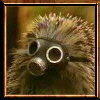
Book 2 of the Kingkiller Chronicles
Rating: 4 out of 5
When people began to criticize old school fantasy as unimaginative, they weren’t talking about the genre itself. What was wrong with old school wasn’t the style; it was the various authors that recycled the same old concepts almost to the point of direct substitution. And so newer, brighter writers began a new trend in fantasy and made it grittier and edgier. And while the new trend undoubtedly propelled fantasy to new heights and made the genre recover its creativity, it seemed something was being left behind. Fantasy seemed to have lost what brought readers into it in the first place: its sense of wonder - the sense that you were in a realm that is magical, a place of dreams.
Sometime in the late 90s, one J.K. Rowling introduced readers to the world of Harry Potter, and proved that fantasy can still go back to its roots and still capture that old magic and captivate the heart and minds of readers with enchantment. All that was needed was a little bit of creativity and heart, even though some of the concepts weren’t quite that original anymore. While the Harry Potter series was aimed for young adults, it didn’t take long until old school magic recaptured the more mature readers.
The enigmatic Kvothe captured the imagination of readers when Patrick Rothfuss unleashed upon an unsuspecting world his first novel, The Name of the Wind. The orphan who clawed his way out a personal tragedy to exasperate the masters of the local University of magic with his silly antics, unwittingly save a town from a fire-breathing dragon-like reptile, and have his heart broken numerous times by the woman of his dreams, has claimed a spot in the pantheon of great fantasy characters in only his first outing (whether this is permanent remains to be seen), in spite of the fact that his story is incomplete and readers have just only seen hints of the person he is to become. Amazingly, Rothfuss has seemingly made Kvothe into some legendary figure even though his accomplishments have yet to be printed in his books. This is probably the first time that a fictional character has gained a reputation before his story has even been completely read. Quite remarkable, considering that the character for most of the story is still struggling to get out of his teens. Also, this only puts much pressure for the author to deliver according to the high expectations he set himself.
So would he live up to it in the second book? The Wise Man’s Fear opens the very next day as the one that ended the first book. Kvothe is back in the University, now promoted in status, with access to materials once forbidden to him, still clawing to find money to support his day-to-day living, still haunted by his thoughts of a particular girl, still determined to chase figures that supposedly only exist in legend, still playing his lute and his music. The book would soon take him to fend off enemies within the university, be sent off to a distant town and fight bandits, perform services for a noble, encounter a beautiful seductress, learn of the ways between sexes, become a fighting machine and rescue fair maidens in the hands of vile men. And before one starts to think that one might have heard of this story before… stop. It isn’t exactly the same one you think you read about. And therein lies the talent of Patrick Rothfuss. He took old school ideas, wove some creativity, and recaptured the magic and the imagination that made old school fantasy so… well… magical.
In The Wise Man’s Fear, readers begin to see more of the world Rothfuss has created, in quite a way unique to the series: by storytelling within storytelling. It is one of its integral themes. Rothfuss while telling his story takes us, at the same time, into the mind of a storyteller. Into the magic of weaving stories to entertain, whether through song, through music or through poetry. And by doing so giving the saga its heart and its passion. And Kvothe’s story is nothing if not passionate – and so is Rothfuss’ storytelling.
There are improvements that come about as Rothfuss having tasted success before. For example, his supporting characters, while mostly almost identical in the first book, are more fleshed out now and have bigger roles. But at the same time there are lingering problems from the first book. It does seem that this book could have benefitted from removing a number of pages. There were parts that it did seem that there was a lot of nothing really going on. Rothfuss also does have some trouble transitioning the story from one story thread to another sometimes making the transition seemed quite forced.
But are these enough to take away from the beauty of the book? Not really. No. The story of Kvothe remains as enigmatic, funny, witty, outrageous, foreboding, grim and marvelous as before. And by the end of the book, readers get a glimpse of the dark larger-than-life personality that Kvothe is stated to become. Not quite there yet, but one could almost taste it in the wind (pun intended). And it’s exasperatingly maddening. But it only makes one sit in exciting anticipation for the coming out of the next part of the story of the man who is reputed to battle an angel for the sake of the woman he loves. And whether this indeed happened remains to be seen.

